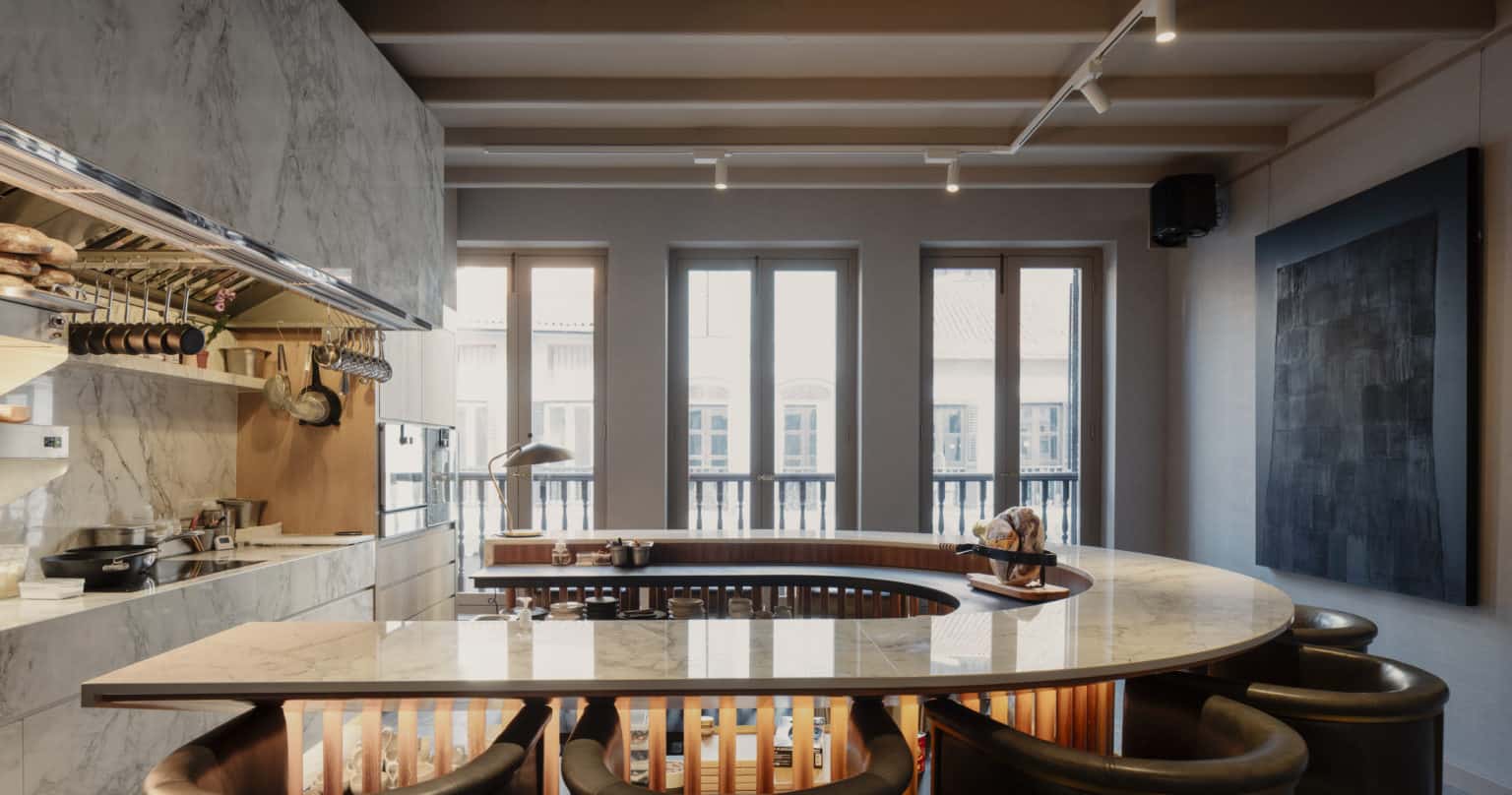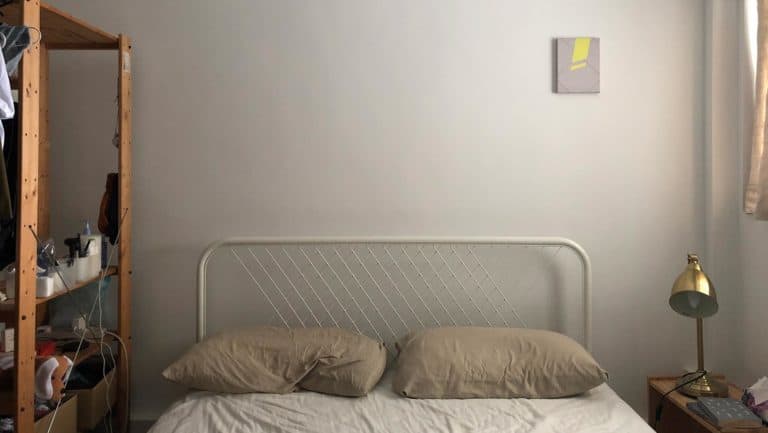When I found out about Table Manners—an art exhibition exploring the topic of food, which was set in a restaurant dedicated to creating experimental dining experiences—I was sold. The exhibition is on show at Restaurant Nouri’s research arm, Appetite, where guests are free to wine, dine, and enjoy music whilst looking at works of art.

When food and art converge
On show are woodblock and digital prints, photographs, videos and performative works by four Southeast Asian artists: Hoo Fan Chon, Elia Nurvista, Kawita Vatanajyankur, and collective Căng Tin. The title Table Manners plays on the word ‘manner’. Whether it’s how we eat or behave around food, each artist explores how food is intricately connected to many facets of our lives and the world, ranging from migration and farming to cultural recipes.

We met up with Appetite’s Art Curator Seet Yun Teng, who took us through an informative tour of Table Manners. It’s Appetite’s first food-themed show despite opening a research arm in 2018 to investigate culinary traditions and culture.
As we listened to Seet’s introduction to the show, upbeat jazzy tunes played throughout the space while restaurant staff and customers walked about. Immediately, I felt a stark contrast to the static, white cube gallery where one would typically view artworks; where the gallery’s pin-drop silence would make me hesitate to exclaim or comment out loud. With music playing all around, the atmosphere felt more casual, relaxed, and comfortable.
Fishy business
The first work brings us to Hoo Fan Chon’s investigations into fish. As a Malaysian artist who grew up in a fishing village and frequently hosted and attended seafood banquets, fish has always been a significant presence in Hoo’s life.
In recent years, Hoo’s usage of fish as a motif became more apparent as he explored how food consumption is heavily influenced and directed by both nature and culture. Hoo’s woodblock print My Earthliness, Your Tenderness takes us through the story of the tilapia fish and its journey throughout Asia.


In an attempt to put together a narrative, we noticed that the print was composed of paddy fields, silhouettes of sewage drains, Singapore’s Merlion and even the Taiwanese gua sha meme. All of the elements come together to feature the tilapia as the superstar.

These components are presented as clues to tell the story of the tilapia, a fish that two Taiwanese soldiers smuggled out of Singapore in 1946, before becoming the cross-bred sashimi-graded Taiwanese Sea Bream that many in Taiwan recognise today.
The left side of the print features a typical tilapia farming scene, while the sewage drain on the right, which shows the Singapore Merlion, suggests its origins. The work reflects on the Tilapia’s journey and how it has undergone processes of change and domestication before slowly being incorporated into Taiwanese culture.
Across the room, sitting beside the shelf of wines is a TV screen playing a 3D animated video of various elaborate fish dishes, reminding me of a wedding that I attended, where I had seen these ingredients in similar dishes.
Previously presented at an exhibition Hoo had put up in Kuala Lumpur, titled The World is Your Restaurant (世界大酒樓), the video work Eight Immortals Crossing the Sea All Fish Banquet frames the banquet format as a representation of the world and its social politics.

In the video, Hoo captured his impressions of the lavish banquet experiences he had with his father by whimsically dressing each fish dish. Accompanying the video is an audio clip announcing each dish’s English and Mandarin names, with peculiar made-up names like All The Way Prosperous Tilapia (1688金鳳魚) and Everything Smooth Marble Goby (66大顺笋壳鱼).
The fish and the dishes’ other ingredients would then ‘enter’ the plate with a little dance, before arranging themselves on the dish. The dishes’ grand entrances and elaborate presentations reminded me of how Imperial Banquets are often portrayed in Cantonese dramas.
Just when you thought you arrived at the end of Hoo’s fixation, Seet brought us to a large print filled with the fish-based dishes we saw in the previous video work. It was Hoo’s last work in the show, depicting a scientific poster of commercial fish species from Malaysia, with the artist portraying each fish as a unique dish.

We exclaimed in delight as we marvelled at the subtle brushstrokes and intricate details that Hoo had added, such as soy sauce, sliced vegetables, spring onions and decorative garnishes. We remarked that these fish are usually not immediately recognisable in their live forms, but with Hoo’s humorous touch, we could identify them through the ingredients they were dressed in with more ease and a lot more fun!
Despite the colours and details that captivated us and led us to discuss each dish’s flavours, we found ourselves referring to the dishes by just that–their ingredients, what they tasted like and the social setting we would typically consume them in–but not the names of the dish nor the fish.
It made me realise that this occurrence was not unique to just fish-based dishes alone. How often are we able to name the exact vegetables we eat daily? How does knowing ingredients’ names and their raw forms relate to the connection we have with our food?
All in all, this generates certain levels of mindfulness and consciousness about where our food comes from, and the journey it goes on before arriving on our plates and eventually entering our bodies.

Seet then introduced us to a photograph by the Vietnamese collective, Căng Tin. It’s part of a larger series based on the collective’s research project on the historical links between the French agricultural colonisation and the province of Lâm Đồng. An enlarged photograph of a fish’s tail in water held our attention, and I was captivated by the soft lighting and semi-abstract portrayal of the subject moving in the water. It was a refreshing pitstop amidst the more figurative works we saw earlier.

Performing with food
At this point in the night, we started to grow hungry from talking about Chinese banquet fish dishes when the tour pivoted to performative and digital works.
Contrasting all the fish-related visuals was a photographic print featuring the artist Kawita Vatanajyankur lying naked amidst an overgrown wheat field, with a curved blade beside her. As part of her broader research on modern agriculture, this photograph showed a constructed field with Vatanajyankur positioning her body as the blade’s handle to create the shape of a sickle—a farming tool commonly used to harvest wheat. Vatanajyankur is interested in portraying the human body as a tool in modern agriculture and mass production, despite the significant reliance on heavy machinery.

A little to the left was the blue glow from a large TV screen placed on a concrete slab, depicting Vatanajyankur once more. In Carrier (Fish), the artist was now using her body as a transportation system for baskets of fish, as an invisible crane pulled her upwards. Instantly recognising how physically demanding this work must have been, comments like “her knees must be hyperextended!”, “imagine keeping your body in this position in a single take,” and “do you think her dress is wet from the fish’s slime?” started rolling out of our mouths.

Projected on the wall beside Carrier (Fish) was another video performance, Safeguarding The Curry Burger by Indonesian artist Elia Nurvista. The video shows a staged, tense global conference with diplomats representing the United States, Japan, England, and India gathering to determine the origin of a fictional curry burger recipe.
As part of a larger research project, The Possibility of Inauthentic Recipes, the work explores the cultural value and ownership of original recipes. Revealing how layers of transformation occur throughout a dish’s history due to cultural exchanges from migration and colonisation, Safeguarding The Curry Burger reflects on the impossible act of distinguishing a recipe’s true origins.

In a multicultural city like Singapore where fusion cuisine is common and even celebrated, Nurvista’s video performance remains highly relatable. Is there any one dish that is truly original? What does authenticity mean when it comes to a recipe?
The work brings to mind the longstanding debate between Malaysia and Singapore on whom chicken rice belonged to. As a small island composed of immigrants from all over the world, how does one trace the roots of a dish we know to be “from Singapore”?
Art in a public space
As we came to the end of the tour, Seet brought us to the research kitchen where customers sit at a U-shaped table to dine omakase-style (where the customer leaves the details of a meal entirely up to the chef).
On the wall hung eight sets of prints that we immediately recognised to be from Hoo’s animated video. These works also evoke a new layer of awareness as one dines here and becomes conscious of the food that’s put before you.

We finally arrived at the source of all the music, when we followed Seet up to a lounge upstairs, filled with shelves of old vinyl for customers to choose from. Hanging over the sofas were the rest of Căng Tin’s photographs. These photographs depicted ingredients that are found in typical Vietnamese dishes in Lâm Đồng today, but were previously imported and grown by French colonists. It brings up the question of originality once again. What makes a dish truly original and authentic? Do the ingredients’ origins contribute to a dish’s authenticity?

As we thanked Seet for the insightful tour, we exited the space feeling refreshed by the perspectives the four artists brought forth. It had us thinking about the food we grew up eating and are so familiar with, but now made aware of its significance in new ways.
From symbolic dishes that make up various cuisines to the journey of the ingredients that construct a local flavour, the works in Table Manners all shed light on food’s connection with the rest of the world.
____________________________________
Table Manners runs till 15 April 2023. Click here for more information.
Feature image courtesy of Appetite.











